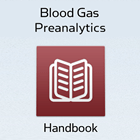Printed from acutecaretesting.org
January 2014
Point-of-care athletes testing, a new approach to sport performance evaluation in high-level athletes
Using POCT has profoundly modified the approach to athletes evaluation, linking sports performance and physiological parameters to the metabolic substratum, basal conditions, functional costs and providing reproducible exercise/functional capacity descriptors [1].
Testing is made in daily changing conditions, in different forms of training, in different meteorological conditions (high/low temperatures, ± excessive), in altitude training camps (≥ 2000 meters).
Defining a personal profile, for high-level athletes during training and races, is another major target.
OUR METHOD
Training testing is defined as testing performance at or near the sites of training or competitions, in the same conditions likely to be experienced in reality. In sports science, usually such tests are not as reliable as laboratory tests, but usually have greater validity because of their greater sports specificity [2].
This is invariably difficult to achieve as there are many factors experienced in competition which are nearly impossible to replicate in training or testing environment. That is why a combination of regular field-based tests (because of the practical and immediate nature of testing) together with occasional laboratory testing (because of accuracy, reliability and quality) is a good option for most sports [4].
To perform these tests, the researcher requires good skills within blood sampling to avoid preanalytical errors, and the tests should be easy and quick. Usually we use a micromethod (≈ 200 µL) that is rapid and easy to perform.
Sampling should also be timed according to the intensity and duration of exercise [3]. To be able to adjust the necessary corrections and achieve optimal training conditions, the results must be given before the next training, which typically is within the same day.
The test results will spark athletes’ interest and desire to continue their hard work. Over 10,000 tests were performed during rest, training, races and post-exercise recovery.
Parameters used were pH, pCO2, HCO3, SBC, blood lactate, electrolytes [5] and, for exercise-related muscle damage, with implications for muscle performance and recovery, AST (serum aspartate aminotransferase), ALT (serum alanine aminotransferase), CK (creatine kinase), LDH (lactic dehydrogenase).
The parameters HCO3 and SBC were used to calculate metabolic cost of exercise (R = SBC / HCO3) in rest, exercise and recovery period [6].
The classifications of R are shown in Fig. 1, where the normal value for R is 1.
A. Basal condition/rest: accepted R values.
EXCELLENT 0.98-1.02
GOOD 0.98-0.96 or 1.02-1.04
POOR < 0.96 or > 1.04
B. Exercise: accepted values for R and Δ R = R exercise – R basal/rest.
Must be correlated with sport performance!
IDEAL! (R < 1.10) + (Δ R = 0.05) +↑ results
RECOVERY! (R > 1.10) + (Δ R = 0.15) + ↓ pCO2 + ↑ sports results
REST! RECOVERY! (R > 1.20) + ↓↓ pCO2
FIG. 1: Classifications for R; Normal value – 1 < 1 or > 1 – suggest metabolic cost of exercise.
The choice of testing will depend on the specific goals of performance evaluation in the athlete, namely exercise-tolerance assessment and training-induced adaptations.
In general, the analytical processes are influenced by the biological material collection, storage, transport and preparation. We should be aware of pitfalls, like incorrect timing of blood sampling, different places of blood sampling, blood clots, air bubbles to avoid data misinterpretation.
OUR RESULTS
For the relevance in reflecting during exercise or post-exercise homeostatic changes and costs, we chose to investigate blood lactate, acid-base status and muscle damage markers (reference intervals are specific for athletes [7]).
In sports performance, excessive efforts to maintain internal homeostasis in normal limits may have limiting, even negative effects on performance capacities. It is possible to appreciate sports-specific energetic requirements (energy systems contribution and efficiency in supporting exercise), functional status in basal/resting conditions and exercise, exercise metabolic costs (R), post-exercise recovery evolution, using calculated functional indexes and blood tests values.
Based on specific changes, we can appreciate performance capacity, reveal the metabolic/muscular/recovery costs, defining also recovery drive.
| Rest | Warm-up | Races | |||
| ≤ 2 min. | ≥ 4 min. | ≥ 25 min. | |||
| pH | 7.39 ± 0.01 | 7.33 ± 0.03 | 7.1 ± 0.06 | 7.09 ± 0.07 | 7.30 ± 0.05 |
| pCO2 (mmol/L) | 41.9 ± 2.9 | 38 ± 5 | 25.6 ± 2.4 | 28.7 ± 3.5 | 29.2 ± 2.3 |
| Base Excess (mmol/L) | –0.7 ± 1.8 | –5.7 ± 1.8 | –21.3 ± 2.7 | –23.7 ± 3.3 | –10.9 ± 3.2 |
| SBC (mmol/L) | 24.9 ± 2.5 | 20.1 ± 2.4 | 9.9 ± 1.4 | 8.8 ± 1.7 | 16 ± 2.2 |
| HCO3 (mmol/L) | 25.1 ± 1.9 | 19.7 ± 2 | 7.7 ± 1.3 | 8 ± 1.6 | 14.05 ± 2.3 |
| R | 1 ± 0.02 | 1.02 ± 0.02 | 1.29 ± 0.07 | 1.1 ± 0.07 | 1.14 ± 0.05 |
| Lactate (mmol/L) | 2.18 ± 1 | 4.6 ± 2.1 | 17.25 ± 2.2 | 19.2 ± 2.6 | 9.02 ± 2.5 |
TABLE I: Different values of acid-base status parameters, blood lactate and R in rest, warm-up and different types of races.
CONCLUDING ABOUT OUR RESULTS
In baseline condition, blood acid-base status, blood lactate and R characterize the condition:- pH values are normal in most cases or reveal a lasting degree of metabolic acidosis;
- pCO2, HCO3, BE, lactate – describe post-effort recovery, with medium to high metabolic costs in certain cases.
- Normal acid-base values: normal pCO2, pH – normal values plus base excess ±
 , lactate
, lactate  , suggest a good general (systemic) recovery plus muscular (local) non-recovery.
, suggest a good general (systemic) recovery plus muscular (local) non-recovery. - pCO2
 , pH
, pH  , base excess
, base excess  lactate
lactate  : systemic and muscular non-recovery.
: systemic and muscular non-recovery. - As particular aspects: hyperlactatemia – normal acid-base status and a blood lactate value of 4 mmol/L.
During exercise, we found several levels of metabolic acidosis plus different degrees of respiratory compensation and subsequent costs (R).
In the post-exercise recovery period, taking blood samples at minutes 1, 3, 5, 7, 10, 20, 30 we created a blood lactate “clearance” curve; the highest value is considered exercise-blood-lactate peak value. The time to reach “blood-lactate peak value“ – index of clearance/fatigue.
Test results are more suggestive if analyzed with sports results:
Significant aerobic endurance capacity = ↑ sports performance + ↓ blood lactate values + ↑ blood lactate clearance rate.
Reduced performance/overtraining = ↓ sports performance + ↑ blood lactate values + ↓ blood lactate clearance rate.
The possibility of POCT to be done in real sports-specific conditions has demonstrated a significant potential to change the way of monitoring sports training and recovery.
Testing is done considering training/race-specific environmental factors: run and bike – road, weather, hills, wind resistance; rowing, canoeing – water conditions, weather, boat friction/water resistance; altitude.
To be able to take valuable coaching decisions, it is essential that the coach receives an experienced support from professionals who can manage the details of training/competition-based testing. POCT can provide information about athlete weakness or limitations, about developing and improving sports performance.
These kinds of testing respect specificity/specific and environmental factors, personal skills, experience and training status, age and sex. It is possible to create the athlete’s profile, from training to performance.
In the world of sports, point-of-care testing almost becomes point-of-training testing.
References+ View more
- Stoian I. Point-of-care athlete testing, a new approach of sport performance - Journal of Sports Science & Medicine 2009; 8, 11 – With European sports medicine congress. October 14-18 2009, Antalya Turkey.
- Dal Monte A, Faina M. Metodi di valutazione funzionale: I test; Specificita. In: Valutazione dell’ atleta, UTET, 1999: 160.
- Dal Monte A, Faina M. Metodi di valutazione funzionale: test per il metabolismo anaerobico lattacido. Lattatemia. In: Valutazione dell’ atleta, UTET, 1999: 195-201.
- Gore CJ. Physiological tests for elite athletes – Australian Sports Commission, Human Kinetics 2000.
- Robergs RA, Ghiasvand F, Parker D. Biochemistry of exercise-induced metabolic acidosis. Am J Physiol Regul Integr Comp Physiol 2004; 287(3): R502-16.
- Talaban MD. Warm-up acid base imbalance in elite woman rowers. 2005, 10th Annual Congress of the European College of Sport Science, 13-16 July, Belgrade, Serbia.
- Mougios V. Reference intervals for serum creatine kinase in athletes. Br J Sports Med 2007; 41: 674-678.
References
- Stoian I. Point-of-care athlete testing, a new approach of sport performance - Journal of Sports Science & Medicine 2009; 8, 11 – With European sports medicine congress. October 14-18 2009, Antalya Turkey.
- Dal Monte A, Faina M. Metodi di valutazione funzionale: I test; Specificita. In: Valutazione dell’ atleta, UTET, 1999: 160.
- Dal Monte A, Faina M. Metodi di valutazione funzionale: test per il metabolismo anaerobico lattacido. Lattatemia. In: Valutazione dell’ atleta, UTET, 1999: 195-201.
- Gore CJ. Physiological tests for elite athletes – Australian Sports Commission, Human Kinetics 2000.
- Robergs RA, Ghiasvand F, Parker D. Biochemistry of exercise-induced metabolic acidosis. Am J Physiol Regul Integr Comp Physiol 2004; 287(3): R502-16.
- Talaban MD. Warm-up acid base imbalance in elite woman rowers. 2005, 10th Annual Congress of the European College of Sport Science, 13-16 July, Belgrade, Serbia.
- Mougios V. Reference intervals for serum creatine kinase in athletes. Br J Sports Med 2007; 41: 674-678.
May contain information that is not supported by performance and intended use claims of Radiometer's products. See also Legal info.
Acute care testing handbook
Get the acute care testing handbook
Your practical guide to critical parameters in acute care testing.
Download nowRelated webinar
Evolution of blood gas testing Part 1
Presented by Ellis Jacobs, PhD, Assoc. Professor of Pathology, NYU School of Medicine.
Watch the webinar









